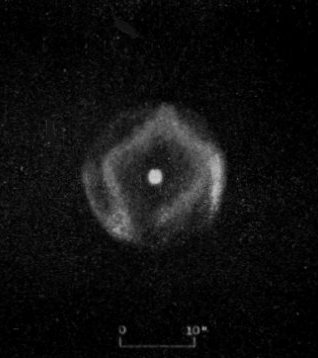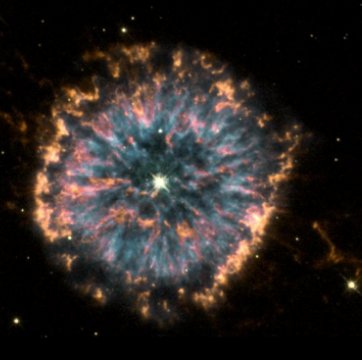NGC 6751
"Nearly round...indistinct evidence of a very irregular ring
formation...rather faint" (Curtis). Indeed, NGC 6751 in Aquila (1.1 degrees due south of Lambda Aquilae) clearly shows
irregularity in Curtis's composite drawing (left) along with a very
prominent 14th magnitude (13.9) central star. The Hubble view on
the right (rotate about 30 degrees to the left for a match) nicely
supports Curtis's, and adds a lot more detail. We see the same
brightening along the western edge, and now a whole set of subtle
radial fingers rather reminiscent of those in IC 3568, though clearer. Moreover, there is
wispy evidence of a surrounding outer shell that extends some 35
percent farther than the inner prominent ring.
Distance is always a problem. The statistical method (which uses
average nebular parameters) gives 8000 light years, but that is
most likely to be an upper limit. At that distance, the inner
shell (21 seconds of arc wide) is 0.85 light years across, the
nebula getting bigger at a speed of 40 kilometers per second.
A central star temperature of 76,000 Kelvin is consistent with a
bit of doubly ionized helium, that and a luminosity of 9200 Suns (again an upper limit) revealing the star
to be in its heating phase following the ejection of its giant-star envelope. The star
has its own broad emission lines that tell of a stiff outbound wind
of the sort often seen in stars still in the heating phase of their
planetary-nebula lives, as mass is
still being lost before they turn into real white dwarfs.
The chemical
composition of the nebula is un-enhanced, showing no obvious
effects of nuclear-processed materials in the predecessor star, which
is now returning more or less pristine matter back into interstellar
space from which it came.
Left: Quote and image by H. D. Curtis from Publications of the Lick
Observatory, Volume 13, Part III, 1918. Right: NASA and the Hubble
Heritage Team (STScI/AURA).



